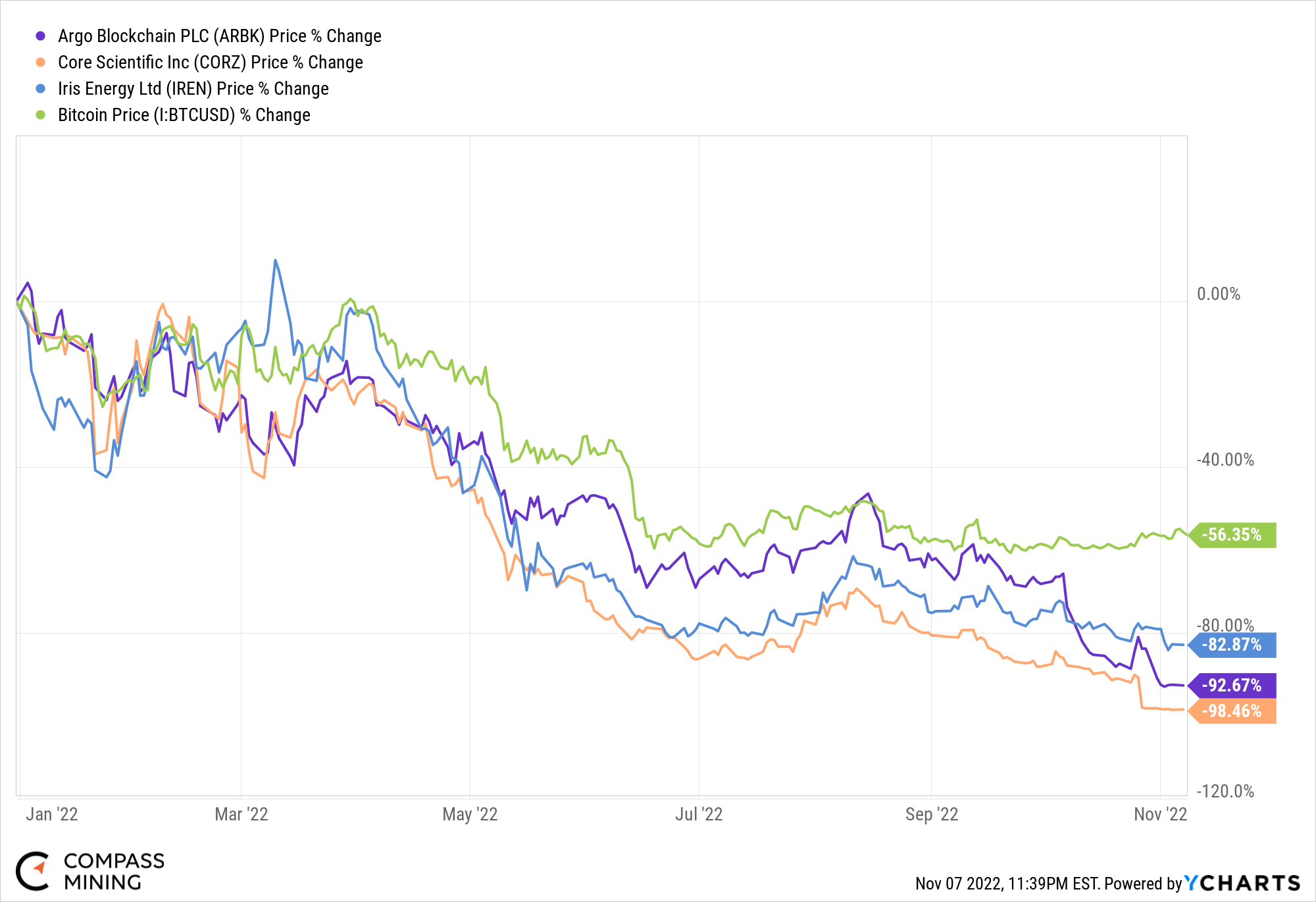

October updates from a number of prominent North American-listed Bitcoin miners cited numerous challenges in meeting their contractual debt repayments.
Many Bitcoin miners took advantage of frothy capital markets over the past two years, collateralizing these loans with Bitcoin and mining rigs. Unfortunately, a drop in Bitcoin’s price necessarily degrades the value of ASICs, forcing miners to provide more collateral or repay more capital payments.
In October, Argo Blockchain, Core Scientific and Iris Energy all made headlines around debt repayment issues. For Argo and Core, the options are extremely limited, with both having announced that they could be forced to curtail operations in the very near future. Iris Energy appears to have outmaneuvered its creditor, NYDIG, meaning it may be able to get through this period relatively unscathed.

Argo Blockchain (ARB.L ARBK)
As highlighted in an August article on the subject – including Argo Blockchain, Bitfarms (BITF) and Greenidge Mining (GREE) – high debt payments and falling Bitcoin prices were increasingly pushing debt-heavy miners into a corner.
After Argo Blockchain failed to receive a much-needed investment from an undisclosed investor, its stock price tanked by 70% in a matter of days. The price is now down nearly 96% from its 52-week high.
The London-based firm made some moves to secure liquidity, including selling 3,843 Antminer S19J Pro bitcoin mining machines for $5.9 million at approximately $15.50 per TH/s to CleanSpark (CLSK).
Core Scientific (CORZ)
One of the world's largest Bitcoin miners, with direct management of some 243,000 ASICs, or about 8-9% of Bitcoin’s hashrate, Core Scientific announced on Oct. 27 that it is running out of cash quickly and that if nothing changes, it too will be filing for bankruptcy by the end of 2022.
With over $1 billion of debt on the balance sheet and over $500 million in current liabilities due to be paid over 12 months beginning June 30, 2022, it wasn’t totally unexpected that the market would be receiving such a communication. All eyes are on how Core proceeds with its debt payments.
Iris Energy (IREN)
Iris Energy has significant board experience in finance, infrastructure, renewables and debt financing. As such, the company set up three separate special purpose vehicles (SPVs) for the sole purpose of financing their mining rigs. The current loan balance as of Sept. 30, 2022, was $104 million.
Unfortunately, the current price of Bitcoin does not generate sufficient margin to cover the serviced debt payments of some $7 million per month, and if no agreement can be resolved with the creditor as to amending the terms of the agreement, it is the intention of the company to default on the next payment, now due on Nov. 8, 2022.
It appears that Iris Energy has been extremely clever in the way the loans have been structured and has almost accepted that defaulting the loans to NYDIG would probably be the best course of action when you compare the value of mining rigs to outstanding debt. There is of course no legal recourse against the main company or its data centers, as the debt is collateralized against the mining rigs only, currently totalling 3.6 EH/s.
The miners held within the SPV have a value of approximately $65-70 million, which is significantly lower than the loan held against them. If the miners are sent back to the lender, Iris Energy would still have access to 2.4 EH/s of miners currently not part of the SPVs. If the company is no longer able to financially support the SPVs, it would also look to consider alternative options that may include hosting and self mining.
Iris also announced that it had utilized the prepayments to Bitmain totalling $83 million by buying miners and immediately selling them to a third party for proceeds of $8.6 million, which will of course help the company in this challenging environment. It has a remaining balance of $75 million with Bitmain.
NYDIG ABL LLC (NYDIG)
A subsidiary of Stone Ridge Holdings, NYDIG is a Bitcoin company that has provided financial services, in the form of loans, to all three Bitcoin miners above, and many other miners.
Its notable due to the high number of machines it took on its balance sheet after loan liquidations. For example, Stronghold Mining recently transferred to NYDIG approximately 26,000 Bitcoin mining rigs that served as collateral under its outstanding debt. Some of these units are likely already racked and ready to hash. But even then, machines require specialized teams, energy contracts and management.
All these miners are precariously close to defaulting on their significant debt repayments to NYDIG. This comes after sources in the company told The Wall Street Journal that they had to lay off 110 employees, about a third of their staff, in September.
- On May 4, 2022, Argo Blockchain announced it had reached an agreement to borrow up to $70.6 million, available in phased payments, throughout the 2nd and 3rd quarters of 2022.
- Since March 2022, Core Scientific has borrowed $77.5 million through a number of loans under the master equipment finance agreement.
- On March 28, 2022, Iris Energy borrowed $71 million backed by 19,800 Bitmain S19j Pro miners.
If there is any silver lining, it’s that lenders might be game to find a path forward for miners. If there’s an understanding that Bitcoin is currently in a bear cycle and that there is sufficient optimism on the future, it’s in most everyone’s interest to make payments manageable for both parties.
